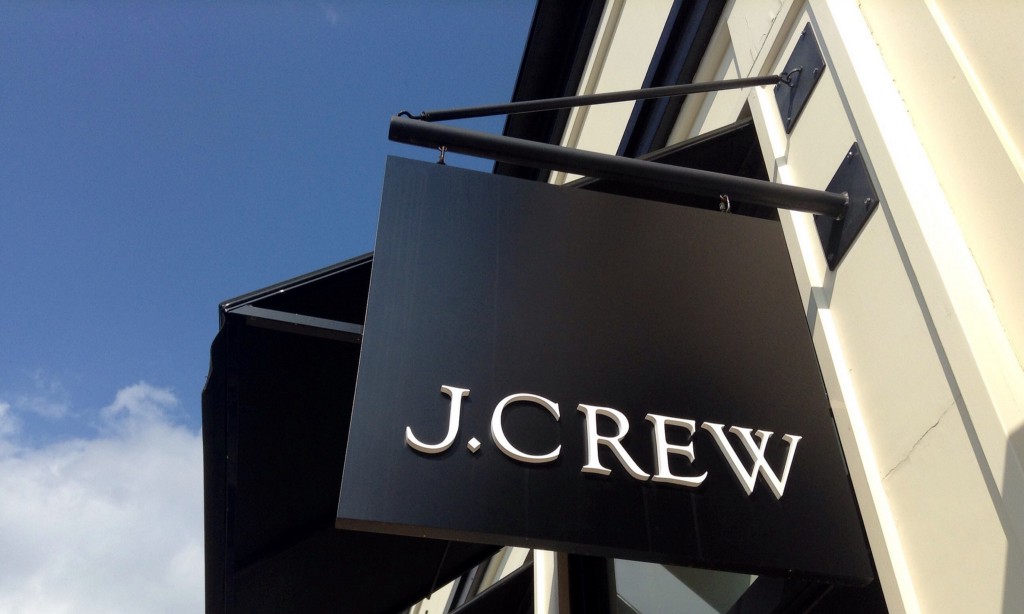RIP J. Crew?
Retail is dying, part 439

In a sort of requiem for J.Crew at the New Yorker, Joshua Rothman considers the factors that have led to the brand’s fall from popularity. The main culprit, of course, is the scourge that has brought so many other retail giants to their knees.
Why J. Crew’s Vision of Preppy America Failed
The short answer is the Internet. Millennials tend to spend money on gadgets, rather than clothes, and rarely go to the mall; savvier customers have learned to wait for coupon codes. The middle of the market has disappeared: while aimless, open-minded shoppers are happy to haunt Zara and H & M, discerning ones turn every purchase into a research project, gravitating toward Web-centric brands such as the California fashion startups Reformation and Everlane, which are more transparent about sizing and manufacturing. Then there is Amazon, which accounts, by itself, for more than half of all growth in online retail, according to the market-research company Slice Intelligence. By allowing customers to search across brands, it devalues branding in general, reducing the potency of the world-building in which companies like J. Crew have invested so much.
J. Crew occupied a very specific space in the market — maistream enough to be available in the malls, but expensive enough to feel aspirational. The “world-building” Rothman refers to is the other piece of the puzzle. For years, J. Crew trafficked in a very specific aesthetic — moneyed, white, preppy to the point of near-parody. That aesthetic was part of its allure. To wear a J. Crew peacoat or a particular pair of ballet flats was a quiet signifier towards a certain kind of lifestyle, a way of sartorial levelling-up.
Classic J. Crew was disrupted with the arrival of Jenna Lyons, the recently-departed president and creative director, who pushed the brand in a more fashion-forward direction, molded in her own image. For those who relied on J. Crew for up-market basics that would be just the thing for interviews and first “real” jobs — blazers, slacks, tasteful sweater sets — the new direction proved to be less useful. Also, prices at J. Crew seemed to skyrocket. Why would I pay $400 for a leopard print coat when I could get the same look at ASOS for $200 less?
The design was indeed the problem. Pushing aggressively fashion-forward looks that didn’t easily translate to real world situations alienated its core customer base.
Over time, however, J. Crew’s designs grew overpriced, eccentric, and even downright ugly. As one J. Crew blogger put it, in a post called “Do You Still Heart J. Crew?,” the company seemed to be “catering to the fashion editors and fashionistas from Fashion Week more than the base of loyal aficionadas”; it tried to create a daring, post-prep aesthetic and overreached. There were quality-control problems, too, and missteps with fit.
Retailers like Everlane have democratized personal style, stripping away the world that retailers like J. Crew crafted so well during its heyday. We don’t need Jenna Lyons’s styling choices anymore, because we can make our own decisions and project our own personal aesthetic onto clothing that is aggressively simple in design. The lack of backstory for a brand means that the consumer can buy a shirt or a pair of pants and build their own story. The essence of a brand doesn’t really need to spin such an elaborate narrative anymore, because we’re all perfectly capable of doing so ourselves.
Here’s Rothman on a recent visit to a J. Crew store.
The most striking thing about the store was, for lack of a better term, its pervasive, all-encompassing J. Crewness. Every item — critter shorts, pocket squares, the Frankie sunglasses — represented a facet of a familiar, imagined life. The names of the products — the Ludlow and Crosby jackets for men; the Rhodes and Maddie pants and Campbell and Regent blazers for women — fixed J. Crew in a certain place and milieu. Once, this was comforting. Now it felt odd to be told by a company that I was, or wanted to be, a certain kind of person. I didn’t want to be a member of the J. Crew Crew, or any crew.
Now that it’s okay to be aggressively, exuberantly individual, J. Crew’s utility has faded. Why buy the Seaside pant for $89.50 and this Tippi sweater with a toucan on it for $79.50 — both meant to impart some sort of Palm-Beach-not-your-grandmother’s-Lilly-Pullitzer aesthetic — when you could very easily craft your own version of your best summer vacation self that’s considerably cheaper and much more unique?
I never really shopped at J.Crew, mostly because they were so expensive. There’s a bi-annual J. Crew sample sale in New York that inspires frenzy in a way that I find extremely disturbing, and even then, the prices are too high. I will say that they make the most excellent swimsuits, in great colors and nice fits that feel sturdy. That is my J. Crew splurge — a holdover from my teen years, when my friends and I pored over the catalogue, debating the merits of the halter top bikini in papaya versus pool blue. I own two bathing suits from them now, purchased on deep discount from their always-excellent sale section. I have my eye on a fetching pineapple-print one-piece. It’s $49.50. That feels fine.
Support The Billfold
The Billfold continues to exist thanks to support from our readers. Help us continue to do our work by making a monthly pledge on Patreon or a one-time-only contribution through PayPal.
Comments